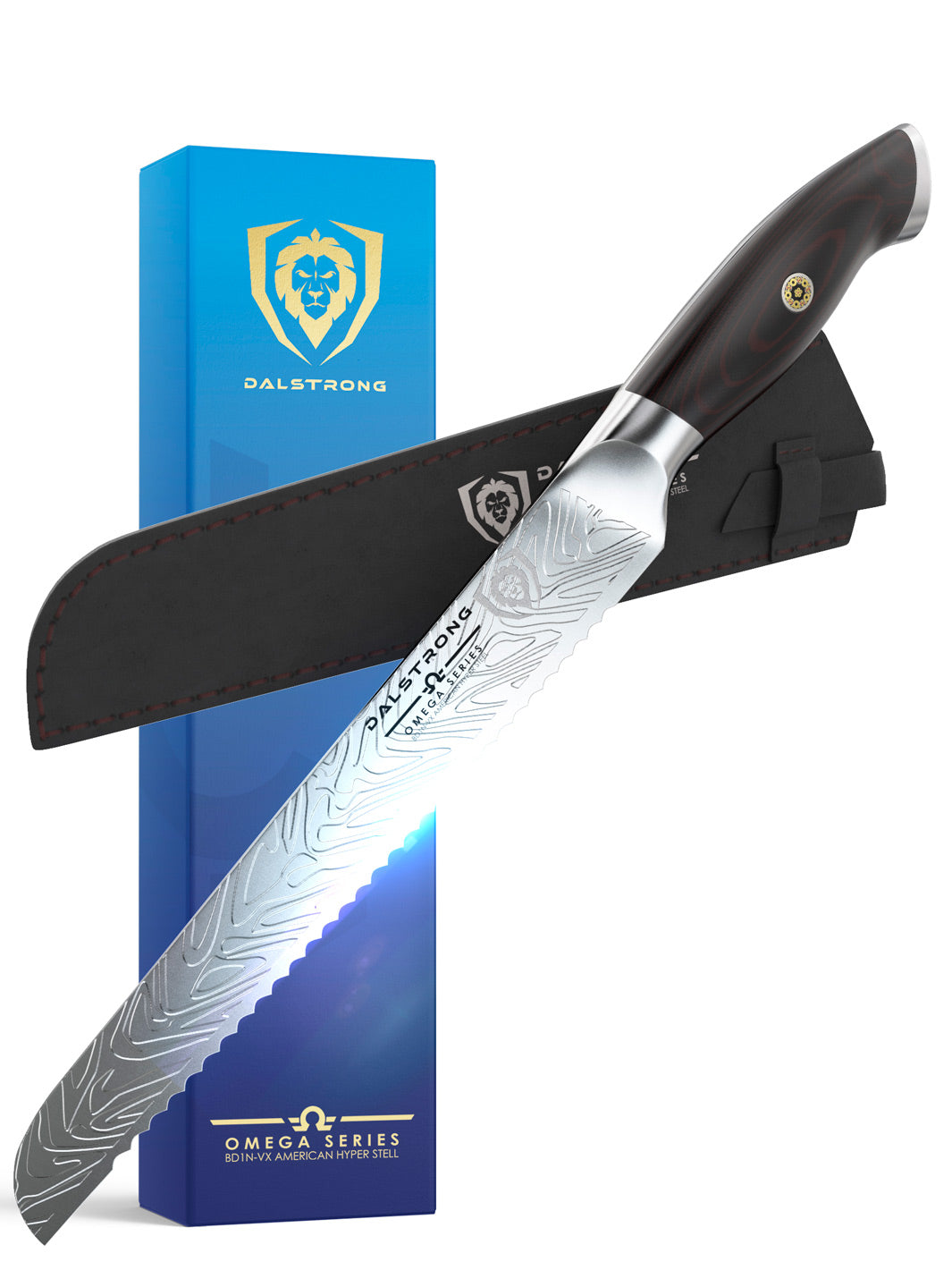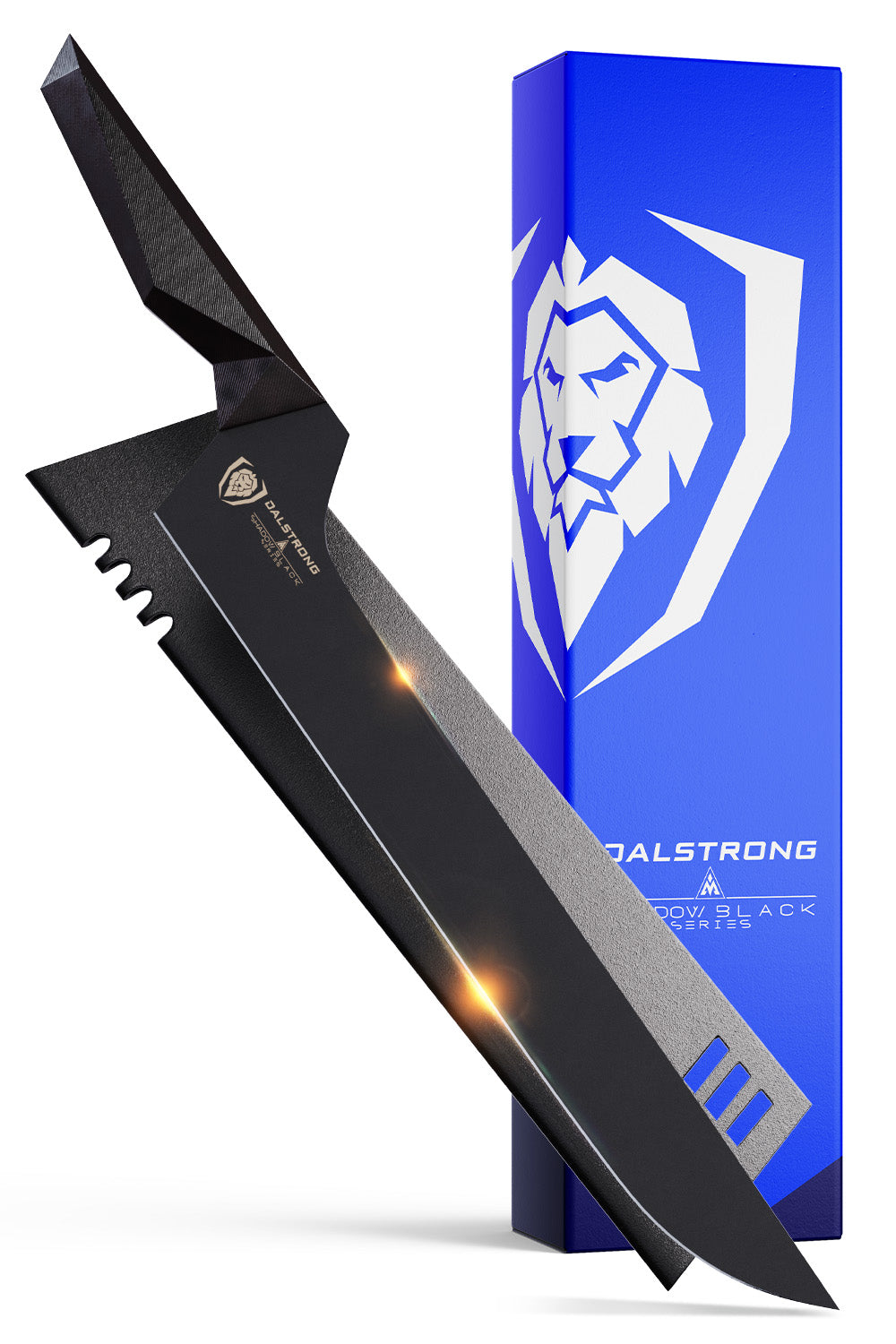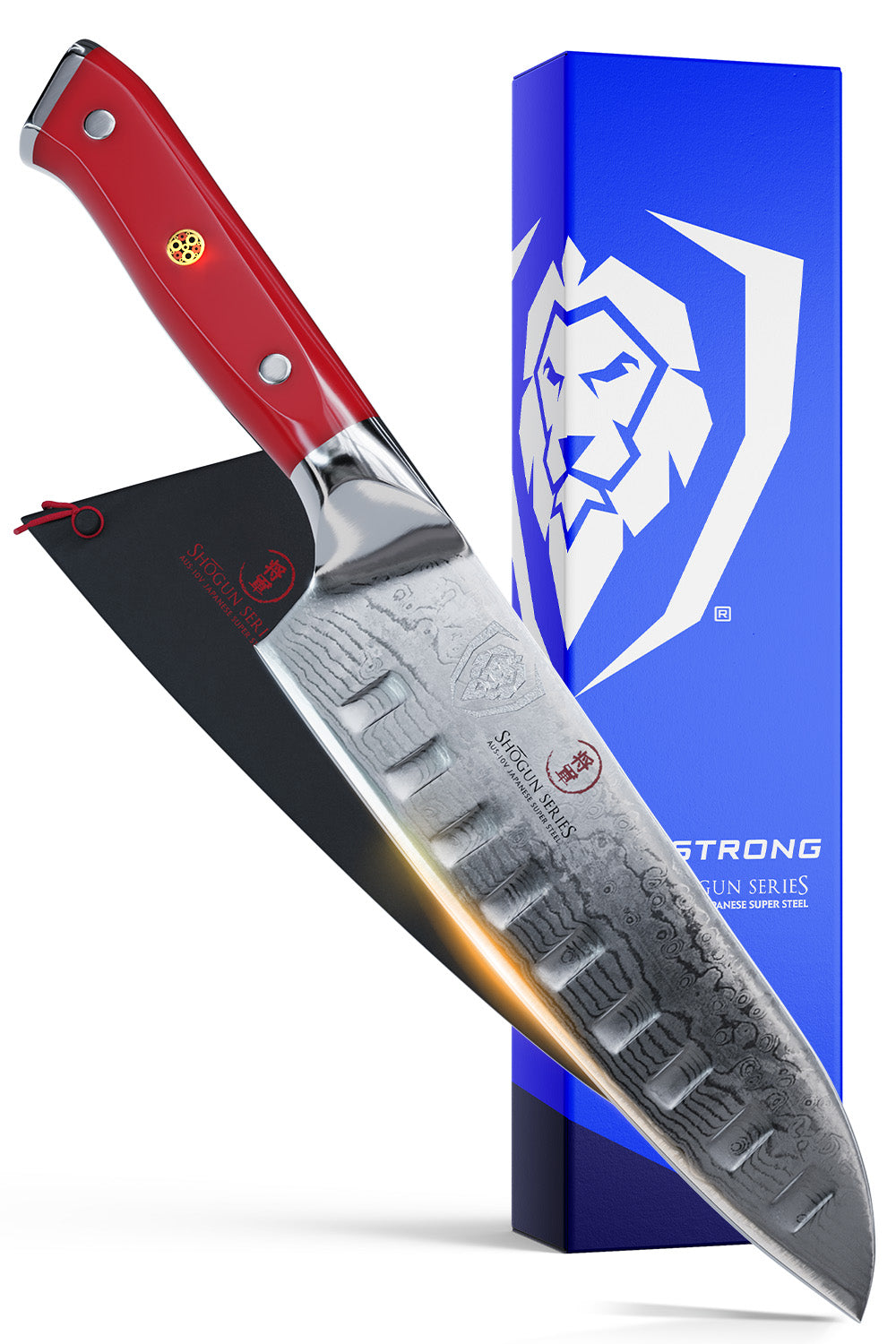 Honing Steel 10" Gladiator Series NSF Certified Dalstrong
Honing Steel 10" Gladiator Series NSF Certified Dalstrong
Honing rods, also known as sharpening steels or honing steels, are essential kitchen tools for knife sharpening and maintenance. They play a crucial role in ensuring that your knives stay sharp and ready for use, making them a must-have item for any cooking enthusiast or professional chef.
At the end of this blog, you’ll be well-versed in what honing rods are and how they can help your knives maintain their shape and angle.
1. What Is a Honing Rod?
 Honing Steel 10" Gladiator Series NSF Certified Dalstrong
Honing Steel 10" Gladiator Series NSF Certified Dalstrong
A honing rod is a versatile tool used to preserve the integrity and sharpness of your knives. It helps in realigning the edge of the blade and removing any small burrs that may have formed during use. Honing rods are commonly made from materials such as steel, ceramic, or diamond, with each material offering unique benefits for sharpening and honing knives.
Choosing A Honing Rod
When using a honing rod, it's important to select the right one for the type of knife you have. Carbon stainless steel knives can be honed using steel or ceramic rods, while serrated knives require specialized honing rods designed specifically for serrated edges. The honing rod should be slightly longer than the blade of the knife you are sharpening to ensure effective sharpening across the entire length of the blade.
2. How Honing Rods Realign Knives
 Honing Steel 9" Shadow Black Series NSF Certified Dalstrong
Honing Steel 9" Shadow Black Series NSF Certified Dalstrong
Honing rods are particularly effective in maintaining the sharpness of straight-edged knives, such as chef's knives, utility knives, and paring knives. They help realign the microscopic teeth on the blade, enhancing the cutting performance and extending the lifespan of the knife.
By regularly honing your knives, you can minimize the need for more aggressive sharpening methods, which can remove more material from the blade and shorten its lifespan.
When choosing a honing rod, consider the material that best suits your needs. Steel rods are durable and can be used for regular maintenance to keep the blade in optimal condition. Ceramic rods are ideal for honing and sharpening delicate knives, as they are harder than steel and provide a finer edge.
Diamond-coated honing rods offer great sharpening performance but are best used when restoring dull or damaged ceramic blades.
Proper knife storage is essential for maintaining their sharpness and overall condition. Knife blocks or magnetic knife holders can keep your knives organized, easily accessible, and protected from damage.
Read about the difference between honing rod and whetstone, here.
3. Difference Between Honing and Sharpening
 Honing Steel 9" Shadow Black Series | NSF Certified Dalstrong
Honing Steel 9" Shadow Black Series | NSF Certified Dalstrong
Folks, I know how confusing it can get when trying to understand what honing and sharpening do for your knives. So, let me make this easier for you.
Honing Process
Honing is the action of realigning the tiny teeth on the blade edge to restore its sharpness. It is performed using a honing rod, also known as honing steel, which helps maintain the knife's edge between sharpenings.
Honing is ideal for straight-edged knives like chef's knives and utility knives. It should be done regularly, as frequent use can cause the blade to slightly misalign. By using a honing rod, you can bring the blade back into alignment, ensuring optimal cutting performance.
Ceramic honing rods are popular for their ability to clear the edge and take off any burrs or imperfections. Regular honing helps extend the time between sharpenings and keeps your knives performing at their best.
Sharpening Process
Sharpening is necessary when the blade becomes dull or damaged and requires more aggressive measures to restore its sharpness. Different types of knives may require specific sharpening techniques. For instance, serrated knives have a unique edge structure, and special sharpeners designed for serrated edges should be used to maintain their functionality.
When sharpening a knife, it's crucial to consider the type of steel used in its construction. Carbon stainless steel knives require specific sharpening methods to avoid damaging the blade. In addition, the angle at which you sharpen the blade can impact its cutting performance.
Professional chefs and home cooks often prefer sharpening sticks or ceramic rods for their versatility and ease of use. These tools provide effective sharpening while ensuring the proper angle is maintained.
By honing and sharpening your knives, you can ensure that they remain sharp, efficient, and ready for any culinary challenge!
4. When To Hone Knives
 Honing Steel 9" Shadow Black Series | NSF Certified Dalstrong
Honing Steel 9" Shadow Black Series | NSF Certified Dalstrong
Are you confused about when you need to really hone your knives? Well, let’s dive into this together.
As a general culinary rule, you should hone your knives regularly, even before they become noticeably dull. Regular honing helps to maintain the blade's edge alignment and extends the time between sharpenings. Chefs and home cooks often hone their knives before each use or at least once a week, depending on how frequently the knives are used.
One of the telltale signs that your knife needs honing is a decrease in its cutting performance. If you notice that your knife is not slicing through food as effortlessly as before or is slipping off the surface, it is a clear indication that the blade's edge alignment has been compromised. Honing the knife will realign the microscopic teeth on the blade, restoring its sharpness and cutting efficiency.
Another factor to consider is the type of steel used in your knife. Carbon stainless steel knives can also benefit from more frequent honing due to their softer blade composition. These knives can lose their edge alignment relatively quickly, especially with regular use. Honing them before each use or every few days can help maintain their sharpness.
Additionally, honing is incredibly important for chefs and home cooks who use their knives often. The more you use a knife, the greater the chances of its blade edge misaligning. Honing before each use or regularly throughout heavy kitchen sessions can help ensure the knife performs optimally.
5. How To Use a Honing Rod
Honing your knives can seem intimidating if you’re a culinary novice. But, these steps will help you get the job done without any complicated steps to look out for.
Proper knife maintenance and sharpening are crucial for maintaining the sharpness and functionality of your knives. Here's a step-by-step guide on how to hone your knives.
- Gather Your Tools: To hone your knives effectively, you'll need a ceramic honing rod, cutting board, and your kitchen knives.
- Choose the Right Honing Rod: Go for a steel honing rod as it provides excellent results and is suitable for various types of kitchen knives!
- Secure the Honing Rod: Place your cutting board on a stable surface. Hold the honing rod vertically, ensuring it is secure and won't slip during the honing process.
- Proper Grip and Angle: Hold the knife handle firmly with one hand and place the blade against the honing rod at a 20-degree angle. Maintain this angle consistently throughout the honing process.
- Start Honing: With light pressure, swipe the blade along the honing rod in a smooth, sweeping motion from the base to the tip. Ensure the entire cutting edge comes into contact with the rod.
- Repeat the Process: Repeat the honing process on both sides of the blade, alternating between each stroke. Aim for around 5 to 10 strokes per side.
- Test the Sharpness: After honing, carefully run your finger along the blade's edge to feel for any burrs or imperfections. If necessary, repeat the honing process until the knife feels sharp.
Expert Tips:
- Consider the factors of blade material, sharpening technique, and honing frequency when maintaining your knives.
- Keep your knives in a knife block or magnetic knife strip to protect their edges and ensure safety.
- Use a separate honing rod for serrated knives, such as bread knives, to maintain their sharpness.
6. Why Steel Honing Rods and Ceramic Rods Are Superior To Diamond Steel Rods
Steel honing rods are favored by many professional chefs and knife enthusiasts for their superior performance and durability compared to ceramic and diamond honing rods. Here’s why that is.
Knife Sharpened to Perfection
Steel honing rods excel in achieving razor-sharp edges on various knives, including paring knives and chef's knives. The honing process with a steel rod helps restore and refine the knife's cutting edge, ensuring optimal performance in the kitchen.
Factors to Consider
When choosing a honing rod, factors such as effectiveness, versatility, and durability come into play. Steel honing rods check all the boxes, making them a preferred tool for professional chefs and home cooks alike.
Reliable Kitchen Tool
Steel honing rods are considered an essential kitchen tool for maintaining knife sharpness. They play a vital role in regular knife maintenance and should be part of every kitchen's arsenal, alongside cutting boards and knife storage solutions.
Edge
Steel honing rods effectively realign and straighten the knife edge, correcting any slight bends or misalignments that occur with regular use. This process ensures consistent cutting performance and prolongs the time between sharpenings.
Superior Durability
Steel honing rods, especially those made of high-quality carbon steel, boast excellent durability, making them long-lasting companions in the kitchen. Their robust construction withstands frequent use without compromising performance.
Versatility Across Knife Sets
Steel honing rods accommodate various types of knives found in knife sets, including Japanese-style knives, utility knives, boning knives, and more. Their versatility allows for efficient honing and maintenance of different blade styles and shapes.
Effective Sharpening Technique
Steel honing rods provide a traditional steeling technique that has been trusted for generations. The honing process with a steel rod is safe and easy, even for beginners, ensuring consistent sharpness and optimal cutting results.
Ergonomic Handle Design
Many steel honing rods feature an ergonomic handle, offering a comfortable grip and precise control during the honing process. This design element enhances user experience and reduces fatigue during extended honing sessions.
7. Recommended Dalstrong Honing Rods
1. Honing Steel 10" Gladiator Series
This honing steel rod from Dalstrong’s Gladiator Series is 10” long and ideal for most kitchen knives. Crafted with high-quality stain-resistant carbon steel, this honing rod features a triple-riveted, ergonomic G10 handle for a solid grip. With its 10” length, it is suitable for most knife sizes without being cumbersome, and the tiny grooves along the surface help bring back and straighten the edge. Built to last in professional kitchens, this honing steel is a must-have tool.
PROS:
- Precision forged from German high carbon steel for exceptional sharpness and wear resistance.
- Ergonomic G10 handle provides heat, cold, and moisture resistance, ensuring durability in busy kitchens.
- Triple riveted construction adds extra strength and longevity to the honing steel.
- Tiny grooves along the steel's surface effectively bring back and straighten the blade edge.
CONS:
- The length of the honing steel may be too long for compact storage in some knife bags, knife rolls, or knife blocks.
- The grooves on the steel's surface may require extra care during cleaning to prevent any buildup.
2. Honing Rod 10" Ceramic Coating
This 10” ceramic honing rod is a premium tool that will gently sharpen your knives back to its original top performance. Crafted with a G10 handle and Dalstrong's unique, scratch-free black ceramic coating, this honing rod ensures your blades are always ready to operate at maximum performance with zero compromises.
PROS:
- 10” length is ideal for most sized knives without being cumbersome or poking too far out of storage.
- High-carbon stainless steel core with scratch-free black ceramic coating is designed for use on valuable steels of high Rockwell Hardness, maintaining blade integrity.
- Triple-riveted black G10 handle offers military-grade durability, heat resistance, and a secure non-slip grip for optimal control.
- Attractively formed bolster protects your hand and allows you to utilize the full length of the rod while sharpening.
CONS:
- The slightly abrasive ceramic coating requires proper cleaning to prevent buildup and maintain its durability.
- The silicon-covered tip, while providing stability and a non-slip grip, may require additional care to prevent damage to delicate surfaces.
3. Honing Steel 9" Shadow Black Series | NSF Certified
Experience maximum performance with Dalstrong’s Shadow Black Series 9" honing steel rod. This rod is the perfect solution for keeping your edge flawlessly aligned and ready to operate at top performance. Handcrafted from high-carbon steel with chrome plating, the Shadow Black Series is built to deliver extra strength and durability.
PROS:
- Crafted from high carbon stainless steel, the honing steel is precision forged to ensure exceptional sharpness, wear resistance, and durability.
- The added chromium plating provides enhanced stain and corrosion resistance, making the honing steel suitable for long-term use in busy kitchens.
- The minute grooves along the surface of the steel rod effectively realign the blade, restoring its razor-sharp edge and ensuring optimal cutting performance.
CONS:
- This honing steel requires proper technique and practice to maintain its durability.
- This rod is designed specifically for knives within the same series so you may want to add a knife from the Shadow Black Series to go with it.
4. Honing Steel 8" Centurion Series
Ensure all your blades are always ready to operate at maximum performance with zero compromises with this 8” honing steel rod from the Centurion series. Carefully handcrafted using high-quality stain-resistant carbon steel, the rod is triple riveted for strength and beautifully finished with an ergonomic and solid-grip handle formed of military-grade G10. Tiny grooves along the steel’s surface work to bring back and straighten the edge.
PROS:
- Crafted from wear-resistant SUS430 steel for exceptional durability and performance.
- The added chromium provides excellent stain resistance, keeping the honing steel looking pristine.
- Fiber-resin military-grade G10 handle offers maximum comfort, grip, and maneuverability.
- Eye-catching design with rings of red and copper, complemented by a copper mosaic center rivet.
CONS:
- This rod is specifically designed for smaller to medium-sized knives.
- This rod requires occasional care for optimal performance and longevity.
5. Honing Rod 10" Frost Fire Series | NSF Certified
Carefully handcrafted using high-quality stain-resistant carbon steel, this honing rod from the Frost Fire series is fixed for strength and beautifully finished with an ergonomic and solid-grip handle formed of premium white resin enclosed in an aluminum mesh.
PROS:
- Crafted with high-quality stain-resistant carbon steel for durability and peak performance.
- Premium white resin handle with an aluminum mesh enclosure and honeycomb finish for a stylish and ergonomic grip.
- Tiny grooves along the steel's surface work to bring back and straighten the edge, ensuring razor-sharp performance.
CONS:
- Designed as a 10" honing steel, may not be suitable for longer blades.
- The white resin handle enclosed in an aluminum mesh may require extra care for maintenance.
8. Frequently Asked Questions
What does a honing rod do?
A honing rod is used to realign the blade of a knife, maintaining its sharpness and improving cutting performance.
What is the difference between a honing and sharpening rod?
A honing rod is used for realigning the edge of a knife, while a sharpening rod is used to remove metal and actually sharpen the blade.
Is it necessary to use a honing rod?
Using a honing rod is not necessary, but it is recommended for maintaining the sharpness and longevity of your knives.














